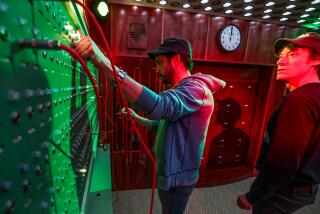Sole to Soul : Meditative walks on labyrinths descended from medieval times are leading many toward spirituality--feet first.
SAN FRANCISCO — The idea may seem silly, says the Rev. Lauren Artress of the Grace Cathedral, but here it is:
Walk into the nave of the elegant Episcopal cathedral on Nob Hill, then step onto a lush wool carpet, its ancient labyrinth design woven in purple and gray across a 37-foot diameter.
As you follow a winding path for 20 minutes or so, you might cry tears of grief or joy, solve the riddle of a messed-up family or work life, feel better about an illness, or gain spiritual insight.
“Walking the labyrinth clears the mind and gives insight. It urges action,” Artress says. “It calms people in the throes of life’s transitions.”
Artress, 49, is the mother of the Christian labyrinth movement. It’s a movement swirling full force from Grace Cathedral into other churches, colleges, workshops and spiritual retreat centers from Indianapolis to Austin, Tex., New York to Anchorage, San Diego to Jackson, Miss.
Preaching in June at the dedication of a labyrinth made by parishioners of Santa Barbara’s Trinity Episcopal Church, Artress testified to how seriously she sees her role: “My job is to be the Johnny Appleseed of the labyrinth.”
Indeed, her business card could read: “Have Labyrinth. Will Travel.” Across America and Europe, she carts a portable labyrinth made of canvas panels linked by Velcro and based on a medieval design whose origins date from at least the 8th Century.
Artress and those who have followed her along this winding path say the labyrinth is opening a long-closed door into mystical spirituality for those inside and outside organized Christianity.
Nora Gallagher, a 45-year-old Santa Barbara writer who attends Trinity Episcopal, became intrigued after visiting Grace Cathedral’s labyrinth. “The people who like it most are boomers,” Gallagher says. “Something without strong doctrinal affiliation is more appealing to them.”
But, Gallagher says, “I’ve been surprised by the number of older people and children who’ve walked it. The kids from the Montessori school next to church ask to walk or even run it.
“It’s an extraordinary tool and hard to describe how it works exactly,” she says. “It’s a walking meditation. For those of us who aren’t easily stilled, it stops you from knowing where you are going. It really slows you down.”
Eventually the Trinity group ordered a $125 kit, designed by Artress and sold by Grace. With the help of a Santa Barbara sailmaker, Trinity made its own labyrinth, with a precise purple path of curves outlined over five panels of white canvas. A circular path leads to and from a rosette-shaped center.
As Anne Roediger lined up on a June Sunday with others--barefoot or sock-footed--to stride onto the newly minted Trinity labyrinth, she explained her fascination. The labyrinth was spread across a parish hall floor, surrounded by candles and plants. A boombox played “Feather on the Breath of God,” a Gregorian chant composed by medieval mystic Hildegard of Bingen.
“A lot of us who are middle aged, we like to try new things, especially if you’ve been career-oriented or child-raising oriented,” the 45-year-old nurse says. “Being a left-brain logical thinker, I found it a helpful tool to get out of that.”
Artress puts it this way: “It takes you out of that place: ‘Oh, my gosh, what am I going to have for dinner? Oh, I’ve got to take my cat to the vet.’ ”
Baby boomers do respond, Artress says, but she faces skepticism. “Three to four years ago, especially, people’s eyes glazed over.”
*
To some, talk of labyrinth walking smacks of one more space shot from California and the New Age. Not so, Artress says. “It’s very Middle Age”--as in 12th Century. As far as she can tell, Grace Cathedral’s is the first church labyrinth installed in 600 years.
Artress’ journey began four years ago when she encountered a labyrinth at a New York workshop led by psychologist Jean Houston. Artress moved quickly from skeptic to adherent to self-taught scholar.
So much so that she went to Chartres Cathedral in France, the home of a labyrinth laid in stone 800 years ago by Benedictine monks. Medieval labyrinths in European cathedrals once were substitute pilgrimage sites for Christians who could not go to Jerusalem.
Although monks sometimes walked the path on their knees, Artress says it’s not necessary to adopt a penitential stance. Dance, sing, chant, do whatever you want, she told the three dozen members of Trinity who came for a workshop. The main idea, she says, is to put one foot after another. You can’t get lost because a labyrinth is not a maze: There’s one way to the center and one way out; no rights, no wrongs.
She offers one caution: “This is not a Ouija board, folks. Don’t ask it yes or no questions. Ask for strength. Ask for courage.”
Regardless of one’s approach, Artress says the labyrinth is perfect medicine for “the mistrust of imagination” rampant today. She explores this in “Walking a Sacred Path: Rediscovering the Labyrinth as a Spiritual Tool,” recently published by Riverhead Books.
With a liberal Christian bent, her book links “sacred geometry” in Christianity to patterns used by Buddhists, Jews, Native Americans and Celts. The labyrinth, she says, is “an archetype found in all religious traditions.” The design replicates “the thumbprint of God.”
Christian labyrinths, such as the one at Chartres, have a particular design that, she says, distinguishes them from others. She adds that the people at Chartres, where 256 chairs cover the design, have been unresponsive to her.
Her book makes clear the theological basis for this. She quotes a Chartres sign, which says the labyrinth “cannot be a magical place where man pulls hidden forces from the Earth. That would be (were one to do so) a perversion of the builders / creators. For in doing so, one would substitute man in place of God.”
That said, joyful dissent takes place regularly at Grace and elsewhere. The Grace labyrinth, patterned after Chartres, opened with the help of singer Bobby McFerrin. People waited up to six hours to walk the path the first time in 1991.
Since then, Artress estimates that 70,000 people have walked Grace’s labyrinth. And the church has distributed 51 labyrinth kits now in use at churches and even in back yards. This month, the cathedral will add a terrazzo labyrinth that will be open 24 hours daily. And Artress is planning for New Year’s Eve, 1999, when she hopes there will be labyrinth “millennium walks” everywhere.
*
Despite these grand plans, among Episcopalians “you’ll find few who know what you are talking about in terms of a labyrinth,” says the Very Rev. Mary June Nestler, dean of the Episcopal Theology School at Claremont.
“I suspect you could call the bishop of Los Angeles and he wouldn’t know about it,” says Nestler, who hasn’t walked one. “But this idea of matching the mind, the feet, the spirit is not new. There’s ample precedent in Western religion and Eastern as well.”
At Trinity in Santa Barbara, the Rev. Mark Asman says he hopes his church can install a stone labyrinth on its lawn. And, echoing Artress’ vision of labyrinths in malls, airports, hospitals, prisons and any place people walk or wait, Asman says the labyrinth may draw the wary and the weary into churches.
Trinity serves lunch to scores of homeless people each day and Asman says he expects to offer them a chance to walk the labyrinth while they wait. Maybe, he adds, a labyrinth could give them some solace, if only for a moment.


